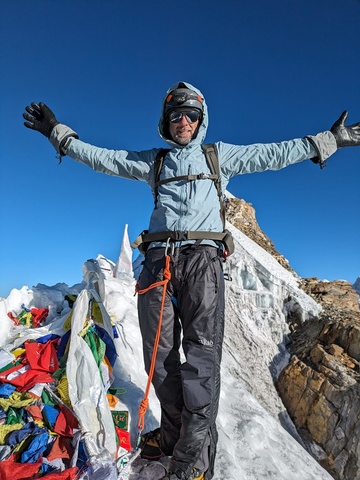For ten blissful minutes, Nathan Frederick (JD04) took it all in from the peak of Mount Everest.
“There was a bright, almost full moon radiating and bouncing light off these dense clouds a few thousand feet below,” Nathan recalls. “There were all these different peaks rising up out of the clouds in the moonlight. It was surreal and gorgeous.”
That was May 23, 2024, about six weeks after Nathan and his wife and fellow mountaineer, Tammy, left their home in Colorado Springs for Nepal. The couple once spent their 16th anniversary on the peak of Mount Kilimanjaro in Tanzania. But this time Tammy, as planned, left Nathan at South Base Camp (elevation 17,598 feet) to complete the trek to the peak on his own.
Nathan hunkered down for a full month at the sprawling camp, waiting for his shot at the summit (elevation 29, 035), while a team of Sherpas cleared the way ahead after the long Himalayan winter. “I spent a lot of time at that stupid camp,” Nathan says with a laugh.
While the wait felt like forever, the long stay did help Nathan acclimate to the altitude. He climbed a different peak (Lobuche, elevation 20,161 feet) during that time, both for something to do and for a training run. He was in constant touch with Tammy and their three daughters via satellite communication. And he nursed his injured knee—he had sustained a serious MCL injury shortly before he left for his expedition, and put off surgery until after his return.
Finally, the time came for Nathan’s ascent. He set off toward his years-long goal—and was almost never heard from again. He quickly encountered the Khumbu Icefall, a lengthy and notorious section of the climb where conditions can be dangerously unstable, especially on the narrow bridges of sheer ice. He was making good time, moving through the icefall at twice the speed of the rest of his group. But he soon hit a terrifying snag.
He got to one of the most precarious ice bridges in the Khumbu Icefall. “There was a large serac [boulder of ice] on the right, and avalanche danger on the left,” he recalls. “You want to get through there as quickly as possible before there’s an avalanche or a massive ice block coming down on you.”

As part of the climbing season’s preparation, Sherpas had laid safety lines from base camp up to the summit, so that climbers, at their discretion, could clip into it with carabiners. Fortunately, with Tammy and their kids in mind, Nathan was clipping in “religiously,” even though it slowed him down a bit.
As he prepared to cross the ice bridge, he watched two Sherpas just ahead of him make it through without much problem and without clipping into the safety lines. Nathan followed, stepping in their precise boot prints.
“Then everything disappeared,” Nathan remembers. “Suddenly I was in a freefall. And then I heard this ‘BOING’ from the tensioning of the safety line on the belay loop on my harness. And I’m hanging there, about 15 or 20 feet down, looking down at hundreds, maybe a thousand feet of nothingness below me. There’s ice on either side of me.”
Fortunately, the lines held, and all the crashing was apparently pretty loud. “The two Sherpas ahead of me heard it and came back,” Nathan says. “They fixed an ice screw and used a pulley system to pull me out.”
Further on, Nathan got another close-up reminder of the mortal danger he had taken on. “You see death every time on that mountain,” he says. “You see bodies off in the distance. But at one point we came across two people who had died just shortly before and were still clipped into the lines. We had to climb over them. That was a tough mental experience.”
But the Everest expedition ended happily for Nathan. He reached the very top of the planet, gathering a lifetime of memories in ten minutes. Then he started back down to civilization, the best shower ever, and home to his family in Colorado Springs.
Nathan, a Cedar Rapids native, is director of IP services at Cardinal Intellectual Property, the nation’s leading IP legal resource provider; he heads the company’s “private side,” which provides IP research and resources for corporations, universities, and law firms. When Nathan returned to work after a life-changing 50 days, he had 11,000 emails waiting for him.
“Adjusting to ‘normal’ life and not climbing life took a little time. But it was good to mentally refocus and re-engage and get back into it,” Nathan says. “There was so much down time in base camp and it was nice to not just be sitting around and freezing.”
Of course, he can’t wait to freeze again. He and Tammy have more mountains to climb as they scale the Seven Summits of the world.
